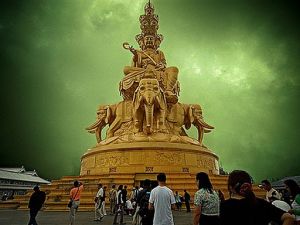A Sadhana of Samantabhadra: The Heart of Mahayana by Tarchin Hearn
Samantabhadra appears as a mysterious presence in many Mahayana scriptures. Often referred to, but rarely appearing, he/she has an ephemeral quality – ubiquitous yet will-o-the-wisp – powerfully present yet difficult to
define or meet with face to face. In the Tibetan Nyingma tradition, Samantabhadra is the name of the primordial Buddha. The same primordial buddha realisation, in the Kagyu tradition, is called Vajradhara. In the very extensive and inspiringly syncretic “Avatamsaka Sutra”, Samantabhadra is portrayed as primordial buddha nature and, as
the archetype of ‘a great and courageous being’, a bodhisattva whose life is completely shaped by a vast and profound aspiration to awaken infinite skilful means in helping all beings. In some traditions the historical buddha, Sakyamuni, is considered to have been a living embodiment of Samantabhadra /Vajradhara.
Generally, Samantabhadra represents all aspects of bodhicitta, both relative and absolute and as such, represents the very heart of the Mahayana tradition. From this perspective, Samantabhadra (as bodhicitta)
manifests through a spectrum of progressive maturation, beginning with ‘aspiration’ (the stage of accumulation). This is followed by: ‘application’ (the stage of
preparation/integration), ‘maturation’ (the two stages of ‘seeing‘ and ‘familiarization‘), and realization of Buddhahood (the stage of ‘nothing further to learn‘). Thus depending on one’s realisation, Samantabhadra is seen either as various expressions of maturing bodhisattva-hood and or as an Adhi-Buddha.
The word ‘dharmatā’ indicates the original nature or condition of reality. ‘Dharmadhatu’ refers to the total field of all events and meanings – the utterly lucid, all encompassing, matrix of knowing. ‘Dharmakaya’ refers to knowing the dharmadhatu; or, put another way, the spontaneously present activity of the dharmadhatu
knowing itself (self-knowing). To meet with Samantabhadra, or to realise Samantabhadra, is to be a living expression of dharmata, dharmadhatu and dharmakaya.
In western understandings of Tibetan Buddhism the word sadhana is often translated as practice and has become largely associated with specified sequences of prayers, and creative imagination, blended with mantra, ritual, and silent contemplation. This particular sadhana is much broader than that. Think of it as a praxis – an integrative way of living – a subtle hint from one heart to another that when activated, can lead us ever more deeply into the mystery of life and living and what it means to be a compassionate, fully engaged and thoroughly awake human being.
May this sadhana serve as a fountain of inspiration for beings who feel warmed by such an approach.
We have just finished a rich 9 day retreat here at Orgyen Hermitage, based around this sadhana. The retreat was called:
Samantabhadra, Natural Awakening, and Contemplative Science
Unedited recordings of these teachings are now available. We have posted them on GDT with the idea that they might add depth of appreciation of how to work with this sadhana.
